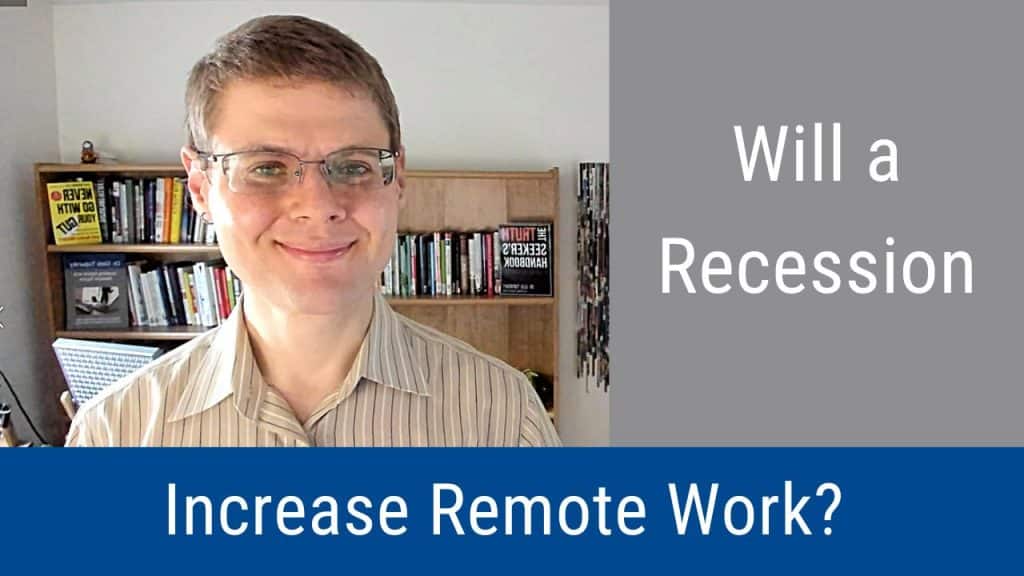
If there is a recession, having most employees working remotely will benefit the bottom line at many companies. Leaders who don’t grasp this reality will fade into irrelevance as economic conditions worsen. That’s the key take-away message of this episode of the Wise Decision Maker Show, which discusses whether a recession will increase remote work.
Video: “Will a Recession Increase Remote Work?”
Podcast: “Will a Recession Increase Remote Work?”
Links Mentioned in Videocast and Podcast
- Here is the article: Will a Recession Increase Remote Work?
- The book Leading Hybrid and Remote Teams: A Manual on Benchmarking to Best Practices for Competitive Advantage is available here.
- You are welcome to register for the free Wise Decision Maker Course
Transcript
Hello everyone and welcome to another episode of the wise decision maker show where we help you make the wisest and most profitable decisions. My name is Dr. Gleb Tsipursky, I’m the CEO of disaster avoidance experts, a future work consultancy that helps sponsor the wise decision makers show. Let’s talk about making wise decisions about remote work in a recession. So will recession, decrease remote work, increased remote work, what’s up with that? You’ve probably seen a lot of headlines where you say that remote work will come and be done in a recession. So headlines are saying that a recession, United States elsewhere will lead to bosses having an upper hand because the labor market will pull down, and they will be able to coerce workers back to the office against the will of them, their employees. Employees notoriously want more remote work than their leaders. And so remote work, according to these headlines will be rolled back due to recession. That, unfortunately, is the wrong narrative, that’s not actually going to happen. I argue that the opposite will occur. Key factors of recession will actually result in more remote work, not less. Let’s talk about why. In a remote session, leaders need to be more disciplined, not less disciplined, they need to focus more on their bottom line, not less than the bottom line. So really focused on ROI getting the most from their investment in the workers in the office space, new technology, everything, you have to cut costs and get maximum ROI. And we have a lot of research that remote work produces better ROI compared to in person work. So this is very, very clear that if you have called full time, or mostly remote working, or maybe have your workers come to the office one day a week, or fully remote work, depending on the scenario, and whatever your company’s needs are, you will get better ROI. Why is that? This is something that’s hard to believe maybe. But we have clear hard data, showing it and leaders in the recession when they have to practice more financial discipline, they need to embrace these facts rather than their intuitions, their feelings about what works and what doesn’t. In terms of remote work in office work, hybrid work. We know from extensive research, there’s really very little use arguing this, that remote work overall boosts productivity, as a lot of studies show surveys extensively show that employees report that they are more productive, quite a bit more productive on average, when they work remotely, especially on their individual tasks. And that’s confirmed that simply by surveys, you might say, well, you know, employees can lie in surveys, because they want to stay home. So they will say that they’re more productive. But we have plenty of other evidence. So for example, we have employees software monitoring data, showing that employees in fact, are more productive when they work remotely. But randomized control trials show that people are more productive when they work remotely. For example, there was a study of a company called trip.com, which is a huge travel agency. And it was randomized. Some of its staff, some programmers, marketing people, financial HR people, some of them asked to stay in the office five days a week. And some people allowed them to work part time remotely in a hybrid mode. And what it found was that those who worked at least part of their time remotely, actually had 35%, better retention, which is great, but we’re talking about productivity. And looking at very, very hard evidence for productivity, the amount of the lines of code written by programmers, programmers who worked part of their time remotely around 8% more code 8% more code. Instead of just being office centric. The Office centric ones naturally wrote 8% less code by comparison. So clearly a randomized control trial over six months, plenty of time to evaluate the impact. We can clearly see in this trial that programmers who are in very hard data are more productive when working remotely. And of course, given all the other data that correlates with other types of skilled workers. And we also know that work from home productivity is improving over time. So that was Stanford University studying this question. It looked at its efficiency and working from home in May 2020, and found that it was 5% more efficient to work from home in May 2020, on average, than move working from the office by May 2022, this number went to 9% 9%. Why this improvement over two years? Well, because we learned how to work together better. We know how to collaborate together better, how to communicate better, we have better technology, home office setup, leadership, and leaders know how to lead teams better, so that improvement in productivity has korone, not shrunk. So this is really important. People are getting better at working from home. What about innovation and collaboration? Leaders often say, Well, people may be individually more productive. But are they really innovating? Are they collaborating effectively? What the research shows is that leaders can’t shoehorn traditional office centric methods to move into a hybrid of remote work for collaboration and innovation. Otherwise, they will indeed suffer collaboration and innovation will suffer if you shoehorn traditional office centric methods into hybrid remote work. So for example, for collaboration, you just the Zoom happy hours, are not a good way of building social bonds. When you look at the research, people are resentful of being forced to have that socialization of zoom happy hours. And because it’s really not nearly as much fun, as in person, happy hours, you don’t get the same dynamics, people don’t enjoy that. So this is bad. You don’t want to do zoom, happy hours with that, that kind of forced socialization in that setting. But leaders keep doing it, because it’s all they know. They don’t know how to do better. There are many, many better practices. Virtually synchronous brainstorming is a much better practice for hybrid and remote teams. And I talk about that, in other episodes the wise decision makers show virtual coworking as an excellent technique to collaborate together. Again, check out the wise decision maker Show episode about this worker autonomy, need to understand and flexibility we know that boosts innovation. So rather than forcing people to go back to the office, giving them autonomy is what’s going to boost innovation, giving them flexibility in their home, is what’s going to boost innovation. And we see that according to a study of 370 Company 307 companies, worker autonomy and flexibility are better, the cause better innovation, that’s really important. We know that the growth and productivity in the pandemic, the growth of the ones was driven mostly by remote. So the productivity growth in the US economy, according to a study by the National Bureau of Economic Research was for service industries relying on work from home like tech finance and so on increase by 1.1% from 2010 to 2019. But during the pandemic year, it increased by 3%. So 3.3%, in fact, was the increase for service industries in productivity during the pandemic era when the large majority of service personnel worked remotely. But for industries relying on in person contact services, so for sale or service industries relying on work from home, the productivity boom was clear, from 1.1% increase per year to 3.3% increase per year, during the two years of the pandemic for the industry relying on in person contact services, restaurants, hospitality, and so on. There was a average increase in productivity of point 6% per year from 2010 to 2019, but a 2.6 decrease in productivity during the pandemic year during the pandemic year. So this is very important for us to understand as well, that we can clearly see that industries, service industries relying on work from home, increase the productivity during the pandemic, those that did not those that are related to in person conflict services, decrease the productivity. So, what’s up with that, while in the recession, we need to understand that companies can save money with remote work. So companies are going to get more productive workers, which of course will save money because they don’t have to hire as many workers to get the same amount of work done. Or in other words, they can get their existing workforce to get more output to use the wood to give them more output. And so if they need the same amount of output, they can let go of some people if they have their staff working remotely versus if they have Office centric staff. Well they need to do it but they will be less productive. So they need to retain their office centric staff. And that’s going to cause companies to be hurt in terms of their bottom line. Now, interestingly, it’s not that people aren’t only more productive with remote settings, they’re also willing to accept less money to keep working from home, which means you have the benefits of higher productivity. And you have the benefits of lower cost, it’s beneficial in both ways. So remote work lessened wage growth by 2%. In the first two years of the pandemic, according to another study from the National Bureau of Economic Research, the reason is that workers value remote work as a big benefit. So they were willing to accept lower wages for remote work, which is great for companies that want to pay less than 64% of people. A top company is free . 1000 workers were willing to forgo 34 30,000 raises for permanent remote work. Think about that $30,000 to 64%, just under two thirds of workers at top companies, that’s a huge amount of money, that you can just not pay workers. If you allow them to work permanently remotely. That’s great, isn’t it, that the cost of labor is going to be down. And hiring remote workers will cost you less in a number of ways. So not only do you have to pay people less because they want remote work. You can also hire employees from anywhere, lower cost of living area, so you don’t have to pay them as much according to the cost of living. And even across the globe, you don’t have to hire employees only in the United States, you could hire them globally. So you, we can see that remote work helps decrease employee costs. And therefore it will be again, another big benefit in the recession. So again, more productive, you don’t have to pay as much money for the same output. And you actually have savings on the cost and because employees are willing to accept lower salaries for remote work. And you could hire employees from lower cost of living areas, whether it whether you’re in your own country or in other countries. Also, we know that work from home improves both recruitment and retention. And of course, you’ll still need to recruit some people even during a recession. So employees prefer to work from home very clearly, six and 10 employees would prefer to apply for a remote job, rather than an office central job, according to a study by Morning consult. And if they’re forced to return to office 64% of workers would look for a new job. According to a study by the ADP Institute. Flexibility is incredibly high in the rankings for job flow for job satisfaction for what people feel satisfied by over retirement benefits over health insurance. The only thing that is higher than flexibility for job satisfaction is compensation. So it’s the only thing that’s higher for flexibility. And we know that people are willing to trade off a significant amount of money for top companies: $30,000 for a call, about two thirds just under two thirds of the workers are willing to trade off $30,000 for additional for the flexibility of permanent remote work. And so that’s according to a study by Future Forum. And we have hybrid work. We’re improving retention by over a third. I mentioned the study with randomized control trials. That was again in the National Bureau of Economic Research. We have similar findings. So these are about companies in the private sector, but public sector employees are government employees, we know the same things apply to them. So a Cisco survey of government employees found that 66% prefer three to five remote workdays, so mostly remote work of three to three to four to five days, working from home per week. 85% flood said flexibility to do remote work increases job satisfaction. Very important. So only 15% want full time office work. And many complaint knees we know are doubling down on the remote work right now. So here’s an example of my client, the Job Center for Health Research, over 85% of its staff in this survey, preferred fully remote work. So this was something that I found and the leadership after deliberating and talking to me of looking at the options decided to adopt the home centric model, where people only come to the office for important meetings or training and if they want to for collaboration, but otherwise working full remotely. Remote work also supports diversity efforts, which is another benefit of remote work. So Some new underrepresented people prefer remote work to office work. For example, there was a survey by Future Forum that found that 21% of white knowledge workers prefer full time office work. What about black knowledge workers? Only 3% Only 3% prefer full time office work, compared to 21% of white knowledge workers. That’s a huge difference. What explains it? Well, remote work is helpful for underrepresented groups. It protects them from microaggressions of various sorts in the office discrimination. And so there’s definitely benefits to monitor represented groups working remotely. And so we know that diversity improves financial decision making. So companies that are more diverse, show higher, show better financial performance. That’s definitely lots of evidence for that. And we also know that diverse teams make overall better decisions. So better decision making better financial performance if you’re more diverse, and remote work facilitates diversity. So an interesting case study of meta, which used to be Facebook, submitted a 2022 diversity report to Facebook. So this is Facebook plus, submit us 2022 diversity report, we find that metal decided to offer some fully remote options early on the pandemic said, Hey, we’re gonna offer some permanent, fully remote options. And that helped it achieve its five year diversity goals two years early. In 2019, meta set a five year plan for diversity, for its diversity goals. And of course, that was way before the pandemic. So set a plan, here’s what we’re going to do by 2024. And then found that already by this year 2022. It achieved its five year diversity goals, two years ahead of schedule. All because underrepresented groups were more interested in remote positions. And so they applied for them in larger numbers. And therefore Mehta achieved its diversity goals, great for meta, and great for any other company that decides to offer fully remote options or mostly remote options. And we know that clearly, diversity is correlated to financial performance and to better decision making. Meals also know that you can save a lot of costs on remote work, you don’t need as much office space expenses associated with Office Space utilities, cleaning security, and so on furniture and so on. That is going to be quite a bit of cost savings. So that’s great. And we know that demand for real estate and rents fell the most in regions offering more remote employment, which again, shows that remote employment results. More remote work results in companies cutting real estate costs and services. And companies should really invest some of that money in providing home office upgrades for their staff. For example, my client, you know, the Information Sciences Institute at the University of Southern California invested heavily into good or home office upgrades for its staff. And that improved staff satisfaction and retention and improved staff productivity and improved staff wellbeing, decreasing their sick leave and absence days, making them again more productive, more retained and better well being all great. So even in a recession, it’s a wise idea to invest into home office upgrades for your staff, it will definitely pay off. Now, the broader narrative here is that traditionalist executives who really want to see workers in the office, they do have to accept the facts. Traditionalist executives eventually will be pulled over the finish line of accepting remote work and recession because they’ll have a lot of cost savings, productivity improvements, and less we leeway remember for personal preferences due to belt tightening. So these traditionalist executives if they want to perform well financially, they will welcome more remote work. And we know that great leaders are leaders who aren’t afraid to change their minds. Surviving recession requires leaders to overcome cognitive dissonance and gut reactions and really accept reality. So courageous leaders embrace change and secondary leaders resist change because of cognitive biases, dangerous judgment errors, mental blind spots, like the confirmation bias, or do we tend to look for information that confirms our beliefs and ignore information that doesn’t, and the ostrich effect the nihilism of negative information about reality? Traditional Leaders resisting these facts will lose up to I can guarantee that so less competent leaders reply more intuition less Some facts as a result in a recession, they will cause their firms to underperform. And they will be replaced by better, more savvy leaders. And so that’s why a recession will increase remote work, it will not decrease remote work. And that’s been another episode of the wise decision maker show. Please make sure to leave a review on Apple iTunes AMA, zone podcast wherever you’re listening to his podcast, or leave a comment on YouTube. If you’re watching the video cast version of this podcast. We have a lot more information about this topic in the show notes with all the citations for the information I discussed in this episode of the wise decision maker show. And I hope that you subscribe to it, whether in iTunes or on YouTube, wherever you’re checking us out. Alright everyone, I look forward to seeing you on the next episode of the wise decision maker show. Again, my name is Dr. Gleb Tsipursky and I’m the CEO of disaster avoidance experts of future work consultancy that sponsors the wise decision makers show and I look forward to you making the wisest and most profitable decisions until I see you again
Transcribed by https://otter.ai
Originally Published at Disaster Avoidance Experts on October 18, 2022.
Bio: Dr. Gleb Tsipursky helps tech and finance industry executives drive collaboration, innovation, and retention in hybrid work. He serves as the CEO of the boutique future-of-work consultancy Disaster Avoidance Experts, which helps organizations adopt a hybrid-first culture, instead of incrementally improving on the traditional office-centric culture. A best-selling author of 7 books, he is especially well-known for his global best-sellers Never Go With Your Gut: How Pioneering Leaders Make the Best Decisions and Avoid Business Disasters (Career Press, 2019) and The Blindspots Between Us: How to Overcome Unconscious Cognitive Bias and Build Better Relationships (New Harbinger, 2020). His newest book is Leading Hybrid and Remote Teams: A Manual on Benchmarking to Best Practices for Competitive Advantage (Intentional Insights, 2021). His writing was translated into Chinese, Korean, German, Russian, Polish, Spanish, French, and other languages. His cutting-edge thought leadership was featured in over 650 articles and 550 interviews in prominent venues. They include Harvard Business Review, Fortune, Inc. Magazine, CBS News, Time, Business Insider, Government Executive, The Chronicle of Philanthropy, Fast Company, Boston Globe, New York Daily News, Fox News, USA Today, and elsewhere. His expertise comes from over 20 years of consulting, coaching, and speaking and training for mid-size and large organizations ranging from Aflac to Xerox. It also comes from his research background as a behavioral scientist. After spending 8 years getting a PhD and lecturing at the University of North Carolina at Chapel Hill, he served for 7 years as a professor at the Ohio State University’s Decision Sciences Collaborative and History Department. A proud Ukrainian, Dr. Gleb lives in Columbus, Ohio (Go Bucks!). In his free time, he makes sure to spend abundant quality time with his wife to avoid his personal life turning into a disaster. Contact him at Gleb[at]DisasterAvoidanceExperts[dot]com, follow him on LinkedIn @dr-gleb-tsipursky, Twitter @gleb_tsipursky, Instagram @dr_gleb_tsipursky, Facebook @DrGlebTsipursky, Medium @dr_gleb_tsipursky, YouTube, and RSS, and get a free copy of the Assessment on Dangerous Judgment Errors in the Workplace by signing up for the free Wise Decision Maker Course at https://disasteravoidanceexperts.com/newsletter/.















